|
|
Visit Us at Salzburger Festspiele
from 12 to 20 August!
|
|
The preparations are in full swing: This August, collectors, art lovers and connoisseurs will meet again in summery Salzburg to enjoy one of the most important cultural festivals in the world – the Salzburger Festspiele. At the parallel ART&ANTIQUE renowned art dealers from all over Europe will be showing their masterpieces in the courtyard of the Residenz from 12 to 20 August.
|
|
P.S.: Until 31 July (inclusive) the galleries in Vienna are open by appointment only. Thank you!
|
|
Besuchen Sie uns bei den
Salzburger Festspielen von 12. bis 20. August!
|
Die Vorbereitungen laufen auf Hochtouren: Auch in diesem August treffen sich wieder Kunstsammler, Interessierte und Connaisseurs im sommerlichen Salzburg, um eines der bedeutendsten Kultur-Festivals der Welt zu besuchen – die Salzburger Festspiele. Auf der parallel dazu stattfindenden ART&ANTIQUE zeigen renommierte Kunsthändler aus ganz Europa von 12. bis 20. August ihre Meisterwerke im Hof der Residenz.
|
|
P.S.: Bis einschließlich 23. Juni sind die Galerien in Wien nur auf Vereinbarung geöffnet. Vielen Dank!
|
|
|
|
Our Highlight of the Month:
|
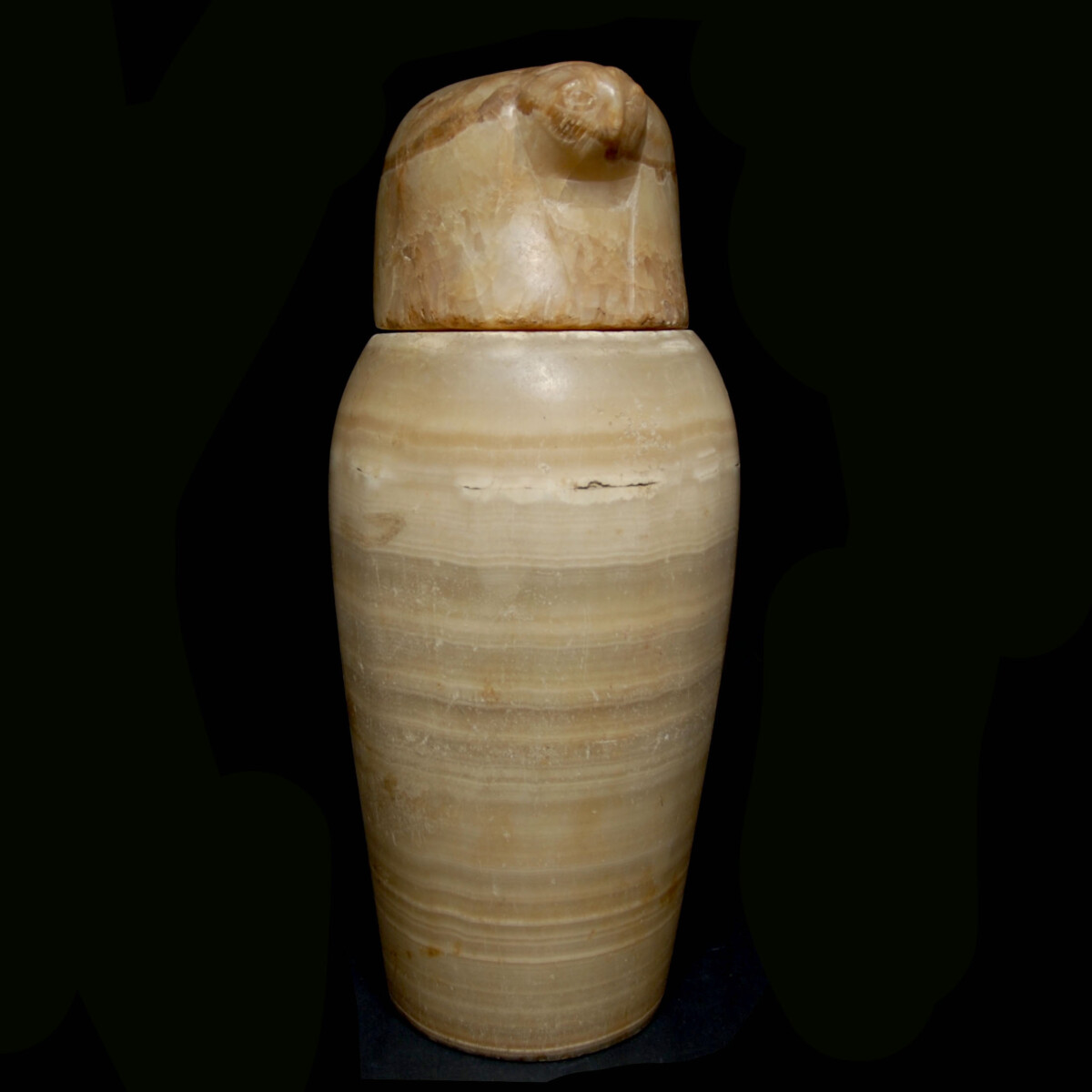
|
|
|
|
|
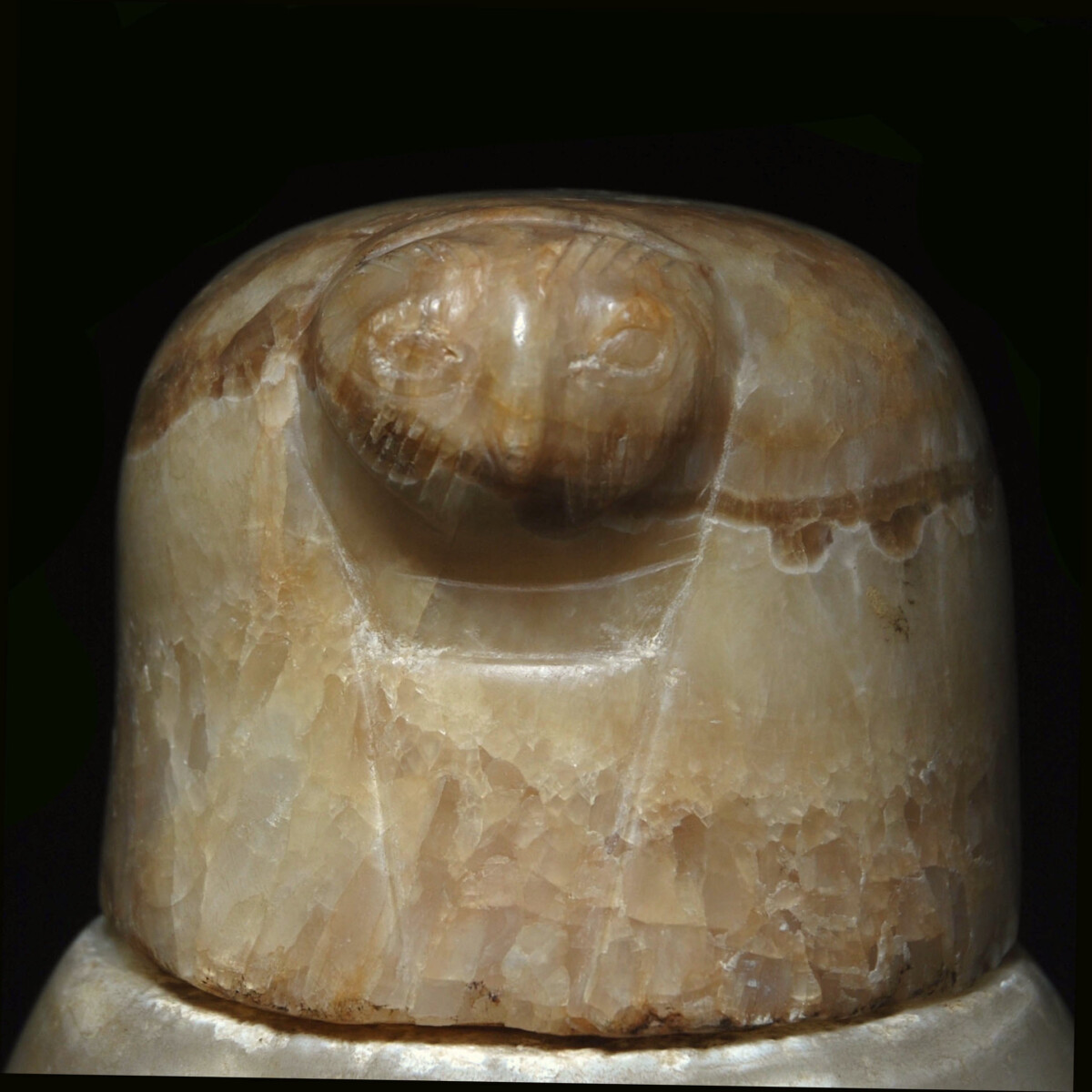
|
|
Egypt – Late period, 664-332 B.C.
|
Exceedingly large canopic jar with a slender, slightly ovoid corpus and flat base. The elegant jar is made of alabaster with a wonderful texture. The lid depicts the falcon headed son of Horus Qebehsenuef, the protector of the intestines. The head of the falcon is sculpturally worked out, the feathers around the pointy beak and the vigilant eyes are finely executed. Qebehsenuef wears a massive wig with two broad lobes cascade in the front. Since the Middle Kingdom the internal organs were under the protection of the four sons of Horus, the tutelary gods of the canopic jars. Duamutef, the jackal, protected the stomach, Hapy, the baboon, the lung, Imsety with the human head the liver and the falcon headed Qebehsenuef the intestines. An impressive, heavy canopic jar. With an old Sotheby’s label.
|
Provenance: Aladdin House Ltd., New York prior to 1966. With an old exhibition photo. There acquired by Dr. Bruce L. Ralston on 10 June 1966. With a copy of the invoice. Thence with Sotheby's New York on 12 and 13 December 1991, lot 318. Last in the English art market.
Dimensions: 42 cm high
Price: 48 000 Euro
|
|
|
Ägypten – Spätzeit, 664-332 v. Chr.
|
Überaus große Kanope mit schlankem, leicht ovoidem Korpus und flacher Basis. Das elegante Gefäß aus Alabaster mit feiner Maserung. Der Deckel zeigt den falkenköpfigen Horussohn Kebechsenuef, den Beschützer der Gedärme. Der Kopf des Falken ist plastisch ausgearbeitet, die Federzeichnung rund um den spitzen Schnabel und die wachen Augen ist fein ausgeführt. Kebechsenuef trägt eine mächtige Perücke, von der zwei breite Lappen vorne herabfallen. Seit dem Mittleren Reich standen die inneren Organe unter dem Schutz der vier Horussöhne, den Schutzgöttern der Kanopen. Duamutef, der Schakal, beschützte den Magen, Hapi, der Pavian, die Lunge, Amset mit Menschenkopf die Leber und eben der falkenköpfige Kebechsenuef die Gedärme. Eine eindrucksvolle, schwere Kanope. Mit altem Sotheby’s-Etikett.
|
Provenienz: Aladdin House Ltd., New York vor 1966. Mit altem Ausstellungsfoto. Dort erworben von Dr. Bruce L. Ralston am 10. Juni 1966. Mit Kopie der Rechnung. Danach bei Sotheby’s New York am 12. und 13. Dezember 1991, Los 318. Zuletzt im englischen Kunsthandel.
Höhe: 42 cm
Preis: 48.000 Euro
|
|
|
|
Selected Artworks of the Month:
|
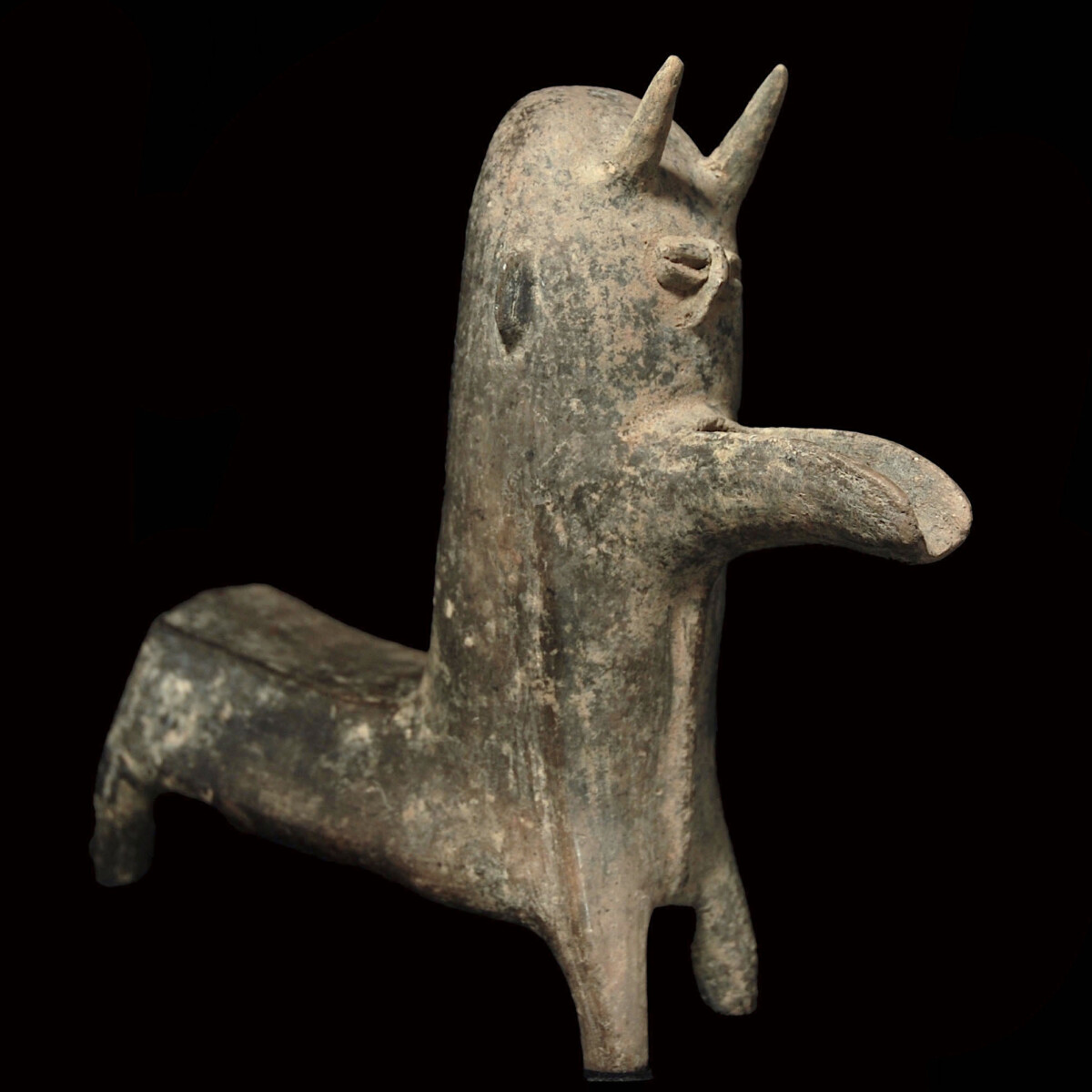
|
|
|
|
|
|
|
|
Iran/Amlash – Early 1st millennium B.C.
|
Rhyton of the Amlash culture of greyish clay in an extremely rare and original form of a bull with anthropomorphic facial features. The mixed creature stands on four stubby legs and has an elongated body with a trapezoidal cross-section. The back is flat. The rear is rounded with a central midrib, which accentuates the short tail. A similar rib runs at the front, below the long snout, it indicates the skin fold on the chest of the bull. The snout itself is worked out long as a groove and served as the spout. The head rises like a phallus, and is rounded at the top, on the sides the ears are protruding. On the forehead two vertical, almost demonic horns. Below a pair of lenticular eyes, which are separated by a slim nose. The almost grotesque depiction makes this vessel an outstanding rhyton of the Amlash culture.
|
Provenance: From an old French collection X. Auctioned with Maîtres Boisgirard et Heeckeren, Paris on 26 September 1980, lot 123. Thence in the collection Magloire, France.
Dimensions: 19.6 cm x 22.8 cm
Price: 16 000 Euro
|
|
|
Iran/Amlash – Frühes 1. Jahrtausend v. Chr.
|
Rhyton der Amlash-Kultur aus gräulichem Ton in überaus seltener und origineller Form eines Bullen mit anthropomorphen Gesichtszügen. Das Mischwesen steht auf vier stummeligen Beinen und hat einen langgezogenen Körper mit trapezförmigem Querschnitt. Der Rücken ist flach. Das Gesäß nach hinten leicht abgerundet mit zentraler Mittelrippe, die den kurzen Schwanz akzentuiert. Eine ähnliche Rippe verläuft vorne unter der langen Schnauze, sie steht für die Hautfalte auf der Brust des Bullen. Die Schnauze selbst ist lang als Rinne ausgearbeitet und diente als Ausguss. Der Kopf ragt phallusartig und oben abgerundet auf, seitlich stehen Ohren ab. An der Stirn sitzen zwei vertikale, fast dämonische Hörner. Darunter ein linsenförmiges Augenpaar, das durch eine schmale Nase abgetrennt wird. Die beinahe groteske Darstellung macht dieses Gefäß zu einem herausragenden Rhyton der Amlash-Kultur.
|
Provenienz: Aus alter französischer Sammlung X. Versteigert bei Maîtres Boisgirard et Heeckeren, Paris am 26. September 1980, Los 123. Danach in der Sammlung Magloire Frankreich.
Dimensionen: 19,6 cm x 22,8 cm
Preis: 16.000 Euro
|
|
|
|
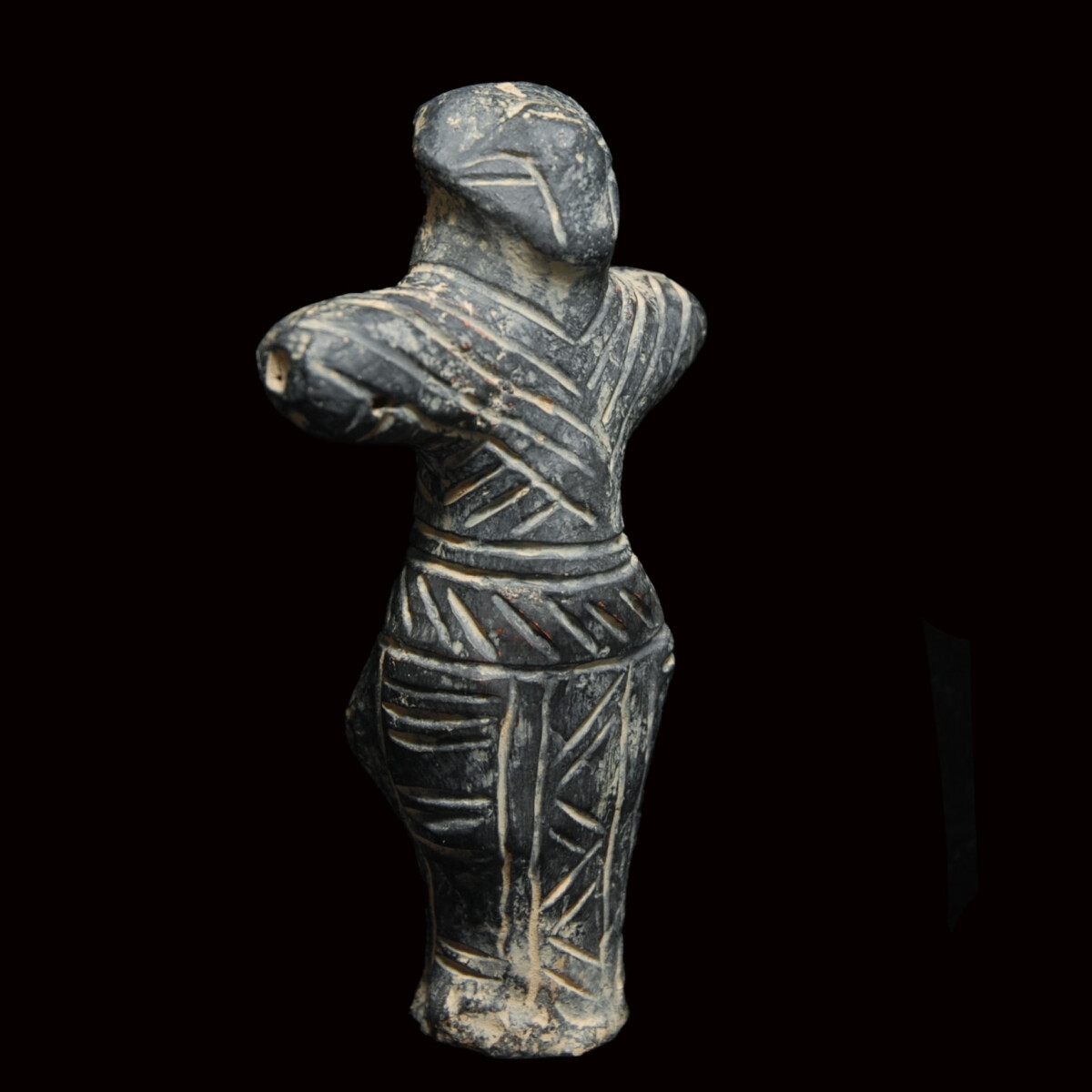
|
|
|
|
|
|
Southeastern Europe – 5500-4500 B.C.
|
Handmade figure of the Vinča culture of dark clay with abundant incised decoration. The small rectangular head with a broad, bulbous nose pointing upwards, the eyes next to it. The female figure with a slender upper body, overbroad pelvis and a far protruding backside. The broad stump arms are horizontally reaching out and are pierced at the ends. The woman wears a dress with a v-cutout which is decorated with deep incisions. Around the belly an incised pattern, which possibly depicts a belt. The legs are not accentuated at the front, the leg cover with horizontal, vertical and diagonal incised ornaments. At the back a deep vertical indent through the buttocks and between the legs. At the back of the head a headcover with two deep perforations. The base is round and smooth. Vinča figures such as the present one were used for ritual purposes. Possibly from the region of Supska-Stublina. With a TL test from the University of Applied Art in Vienna. Mounted.
|
Provenance: From the well-known Vinča collection of D. J. (1956-2015), since 1970 in Austria.
Dimensions: 11 cm high
Price: 19 000 Euro
|
|
|
Südosteuropa – 5500-4500 v. Chr.
|
Handgeformte Figur der Vinča-Kultur aus dunklem Ton mit reichem Ritzdekor. Der kleine eckige Kopf mit breiter, knolliger Nase, die nach oben gerichtet ist, die Augen daneben liegend. Die weibliche Figur mit schmalem Oberkörper, überbreitem Becken und einem nach hinten weit ausladendem Gesäß. Die breiten Stummelarme stehen waagrecht ab und sind an den Enden gelocht. Die Frau trägt ein Kleid im V-Ausschnitt, das mit tiefen Ritzungen verziert ist. Um den Bauch ein Ritzmuster, das wohl einen Gürtel darstellt. Die Beine sind vorne nicht akzentuiert, das Beinkleid mit waagrechter, vertikaler und diagonaler Ritzverzierung. Hinten eine tiefe vertikale Einkerbung durch die Gesäßbacken und zwischen den Beinen. Am Hinterkopf eine Kopfbedeckung mit zwei vertieften Lochungen. Die Standfläche rund und glatt. Vinča-Figuren wie diese wurden für kultische Zwecke eingesetzt. Wohl aus der Gegen von Supska-Stublina. Mit TL-Test der Universität für Angewandte Kunst in Wien. Gesockelt.
|
Provenienz: Aus der bekannten Vinča-Sammlung von D. J. (1956-2015), seit 1970 in Österreich.
Höhe: 11 cm
Preis: 19.000 Euro
|
|
|
|

|
|
|
|
|
|
Greece/Canosa – 3rd century B.C.
|
Exceedingly vigorous and lifelike terracotta sculpture of a horse from Canosa. The animal in a rearing up posture with raised forelegs and slightly downwards hooves. The hindlegs with tensed muscles are also stretched out. The tail is raised. Legs, back, flank, belly and chest are anatomically diligently modelled. The head with a short, thick mane is also worked out in detail – with eyes and bulging brows, with a strong, closed mouth. Parts of the bridle are still preserved. On the forehead, on the ganaches, as well as around the mouth disc-shaped decoration, which lends the animal a special status. Horses were considered as a symbol of prosperity during the Hellenistic period and were found as high-quality statuettes for votive offerings in tombs and temples. A perforation on the back assumes that a rider, which was seperately worked out, once sat on the back of the animal. See for the typus the statuette in the Museum of Fine Arts in Boston with the Accession Number 1981.385a-b. Mounted.
|
Provenance: Belgian private collection, acquired in November 1996 by André de Munter Archéologie in Brussels, Belgium. With a document by André de Munter, as well as an old photograph of November 1996.
Dimensions: 24 cm x 25.5 cm
|
|
|
Griechenland/Canosa – 3. Jahrhundert v. Chr.
|
Überaus kraftvolle und lebensechte Terrakotta-Skulptur eines Pferdes aus Canosa. Das Tier in aufbäumender Haltung mit angehobenen Vorderbeinen und leicht nach unten gewandten Hufen. Die Hinterbeine mit angespanntem Sprunggelenk sind ebenfalls durchgestreckt. Der Schwanz ist angehoben. Beine, Rücken, Flanke, Bauch und Brust sind anatomisch sorgsam modelliert. Der Kopf mit kurzer dichter Mähne ist ebenfalls detailgetreu ausgearbeitet – mit Augen und wulstigen Brauen, mit kräftigem, geschlossenem Maul. Teile des Zaumzeugs sind noch erhalten. Auf der Stirn, an den Ganaschen sowie rund um das Maul scheibenförmige Verzierung, die dem Tier einen besonderen Status verleihen. Pferde galten im Hellenismus als Zeichen des Wohlstands und wurden als hochwertige Statuetten als Votivgaben in Gräbern und Tempeln gefunden. Eine Lochung am Rücken macht deutlich, dass am Rücken des Pferdes ein separat gearbeiteter Reiter saß. Vergleiche zum Typus die Statuette im Museum of Fine Arts in Boston mit der Accession Number 1981.386a-b. Gesockelt.
|
Provenienz: Belgische Privatsammlung, erworben im November 1996 bei André de Munter Archéologie in Brüssel. Mit Dokument von André de Munter sowie alter Fotografie von November 1996.
Dimensionen: 24 cm x 25,5 cm
Preis: 8.000 Euro
|
|
|
|
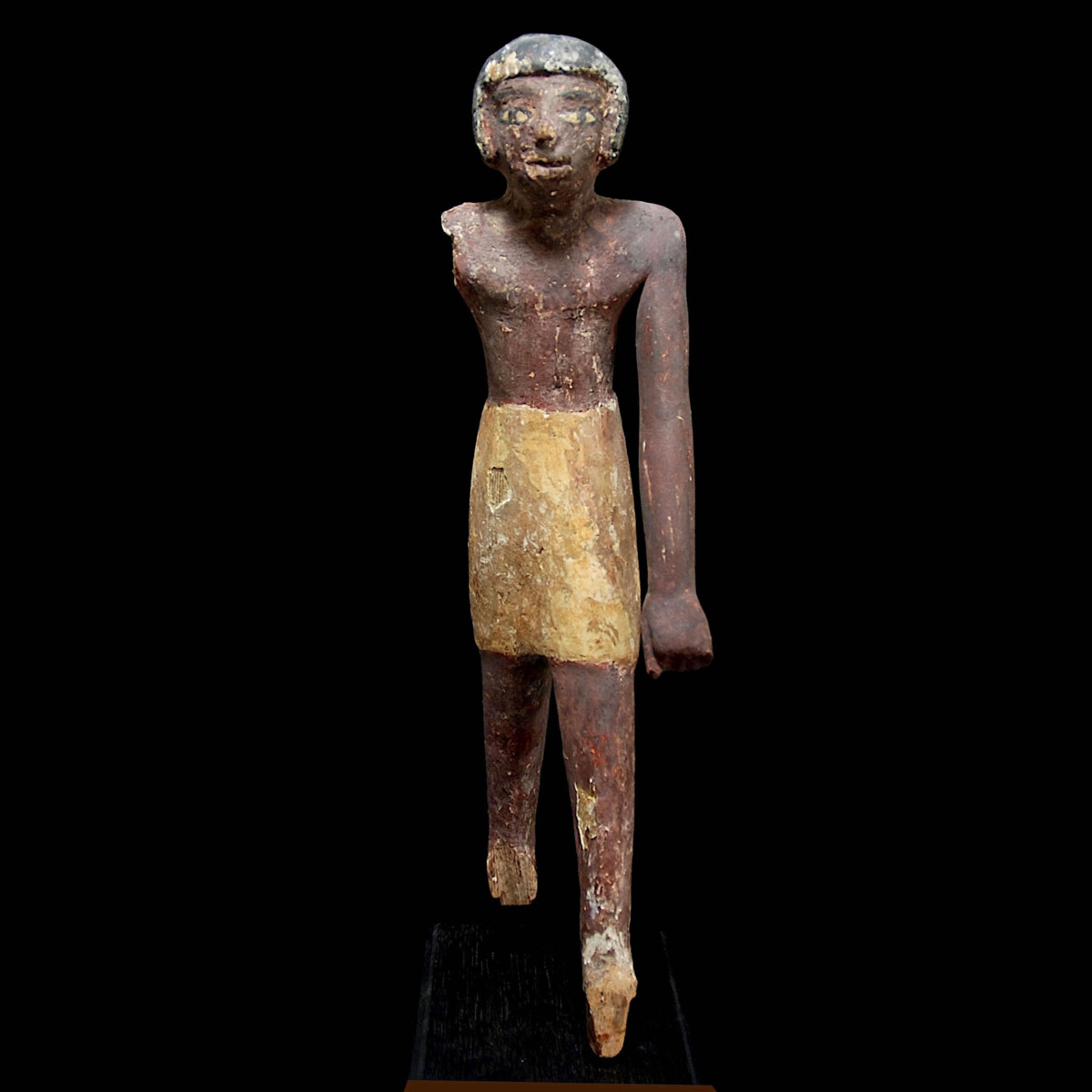
|
|
|
|
|
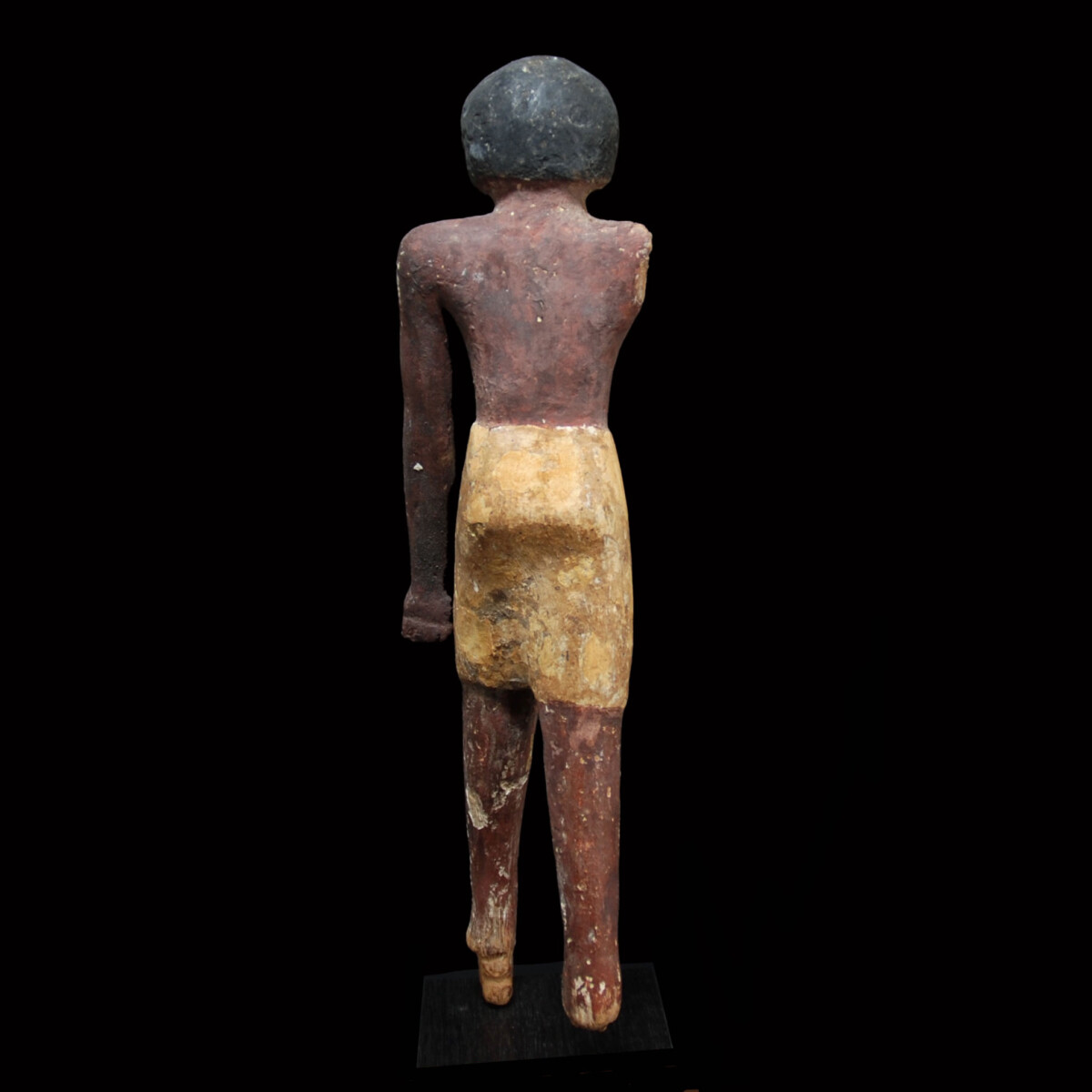
|
|
Egypt– Middle Kingdom, around 2000-1800 B.C.
|
Large wood figure of a striding man, possibly a servant. His left foot is put forward and the gaze straight ahead. The face is roundish, the mouth slightly open. Eyes and brows are painted in white and black. The dark brown skin tone of the figure indicates the possible Nubian origin of the servant or worker. He wears a dark black wig and a white apron around his hip. The left arm is straight, the hand formed to a fist. The horizontal perforation through the fist indicates that he once held a tool. At the bottom of the feet tenons are still preserved, where the figure is mounted on a wood base. With beautifully preserved polychromy. See for the type Bonhams auction London on 27 April 2006, lot 7. Mounted.
|
Provenance: From the private estate of the well-known Parisian art dealer François Antonovich (born 1934), acquired in the 1970s.
Dimensions: 31 cm high
|
|
|
Ägypten – Mittleres Reich, etwa 2000-1800 v. Chr.
|
Große Holzfigur eines schreitenden Mannes, wohl eines Dieners. Er hat das linke Bein vorangestellt und den Blick geradeaus gerichtet. Das Gesicht ist rundlich, der Mund leicht geöffnet. Augen und Brauen sind in Weiß und Schwarz aufgemalt. Die dunkelbraune Hautfarbe der Figur verweist wohl auf die nubische Herkunft des Dieners oder Arbeiters. Er trägt eine kurze schwarze Perücke und einen weißen Schurz um die Hüften. Der linke Arm ist gerade, die Hand zur Faust geballt. Eine horizontale Lochung durch die Faust weist daraufhin, dass er dort ein Werkzeug hielt. An den Unterseiten der Füße sind noch Zapfen erhalten, über die die Figur in einer Holzbasis eingelassen war. Mit schön erhaltener Polychromie. Vergleiche zum Typus Bonhams Auktion London vom 27. April 2006, Los 7. Gesockelt.
|
Provenienz: Aus dem Privatbestand des bekannten Pariser Kunsthändler François Antonovich (geboren 1934), erworben in den 1970er Jahren.
Höhe: 31 cm
Preis: 6.000 Euro
|
|
|
|
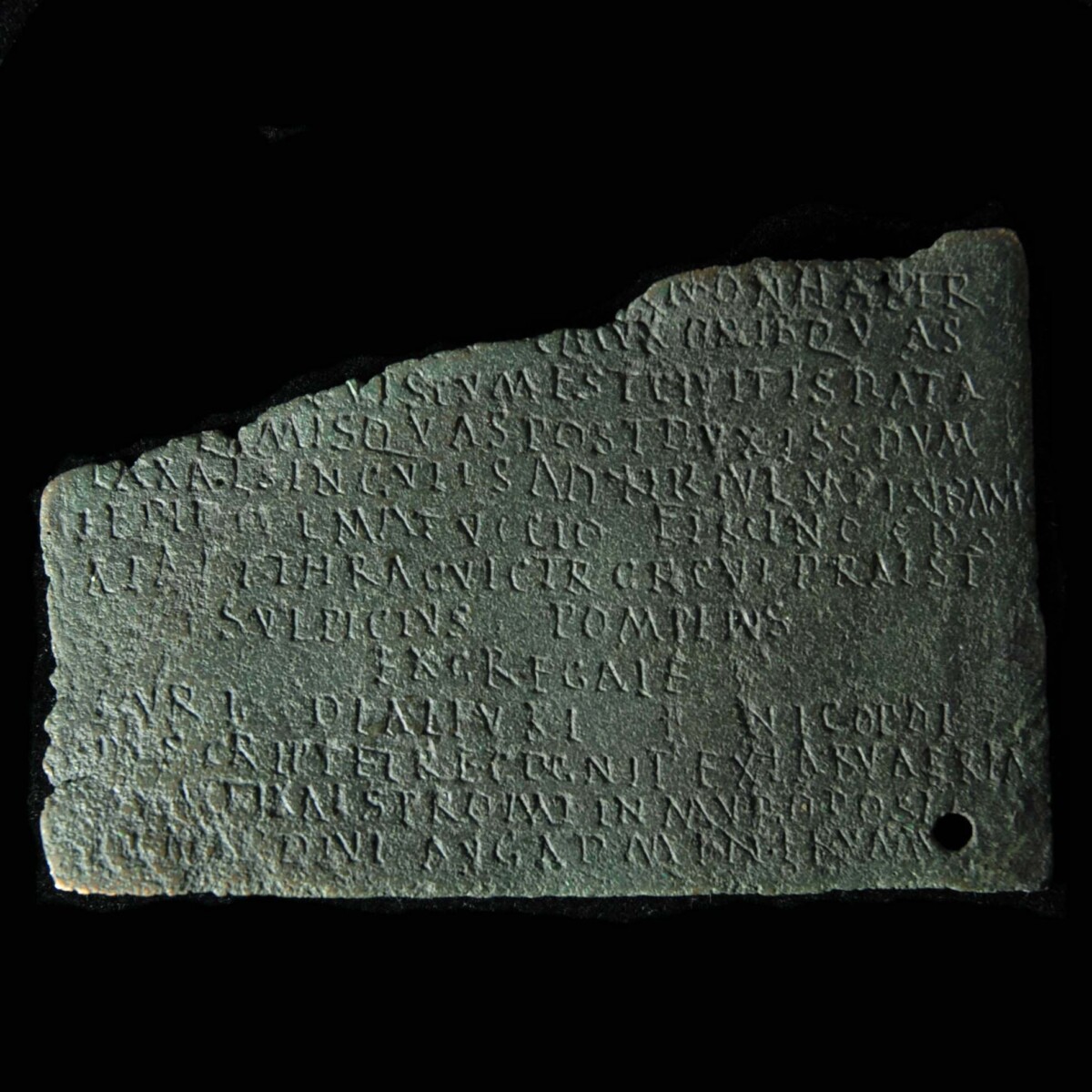
|
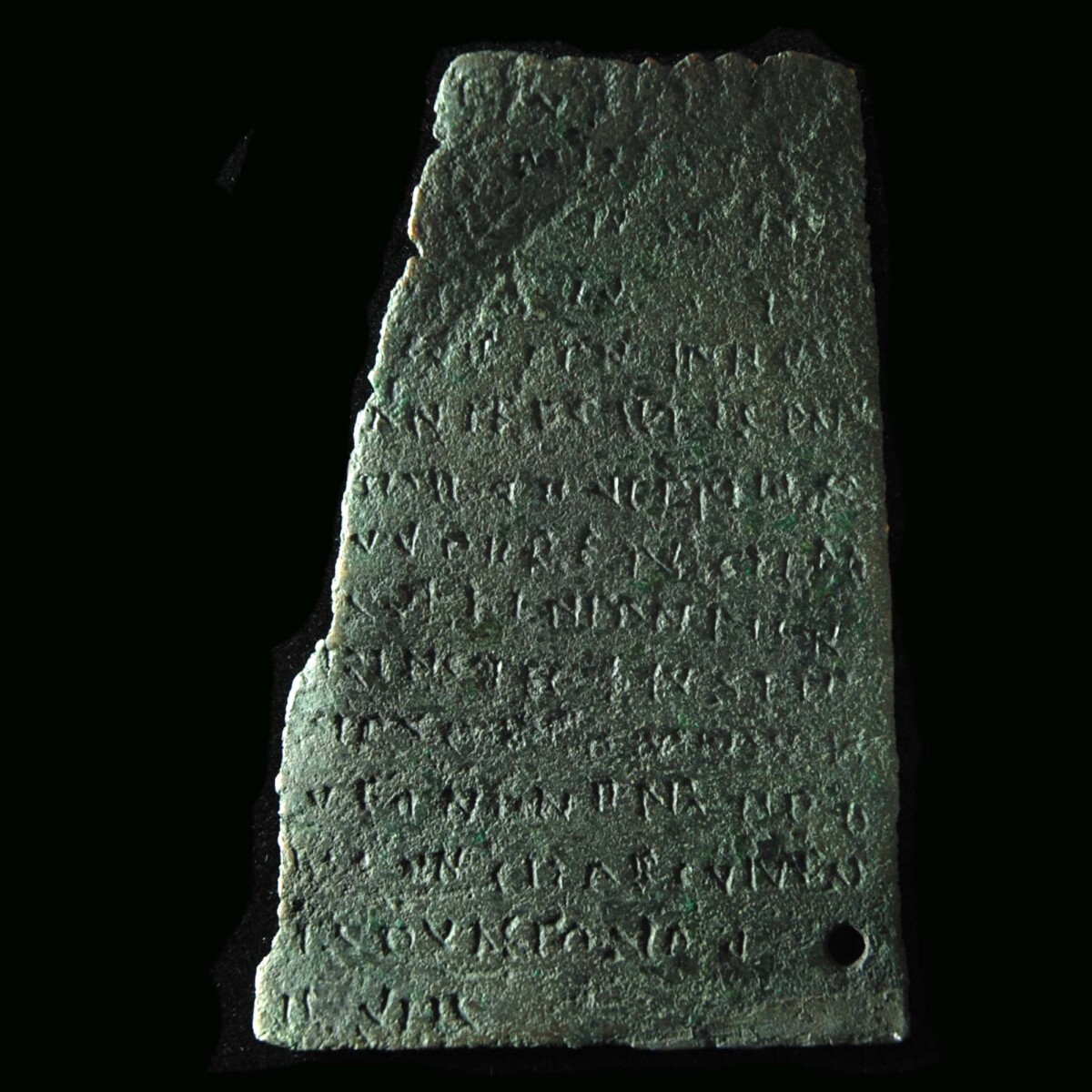
|
|
Roman Empire – 21 June 159 A.D.
|
Fragment of a military diploma from the period of Emperor Antonius Pius. Preserved is the lower part of Tabella I. The constitution for Pannonia Superior was declared on 21 June 159. Mentioned are five Alae and six cohorts. The recipient of the military diploma served in Ala I Thracum victrix civium Romanorum. His name is Suris, son of Dialpurus. He possibly is from Nicopolis ad Nestum (today’s Bulgaria). Published in: P. Holder “Roman Military Diplomas V (2006)”, p. 845 f., no. 422. As well as in: Peter Weiß “Chiron 29”, 1999, p. 148-182.
|
Provenance: From the German collection Peter Weiß, acquired between 1967 and 2015.
Dimensions: 5.9 cm x 9 cm
Price: 4 800 Euro
|
|
|
Römisches Reich – 21. Juni 159 n. Chr.
|
Fragment eines Militärdiploms aus der Zeit des Kaisers Antoninus Pius. Erhalten ist der untere Teil der Tabella I. Die Konstitution für Pannonia superior wurde am 21. Juni 159 ausgesprochen. Erwähnt werden fünf Alae und sechs Kohorten. Der Empfänger des Militärdiploms hat in der Ala I Thracum victrix civium Romanorum gedient. Sein Name ist Suris, Sohn des Dialpurus. Er stammte wohl aus Nicopolis ad Nestum (im heutigen Bulgarien). Publiziert in: P. Holder „Roman Military Diplomas V (2006)", S. 845 f., Nr. 422. Sowie in: Peter Weiß „Chiron 29“, 1999, S. 148-182.
|
Provenienz: Aus der deutschen Sammlung Peter Weiß, erworben zwischen 1967 und 2015.
Dimensionen: 5,9 cm x 9 cm
Preis: 4.800 Euro
|
|
|
|
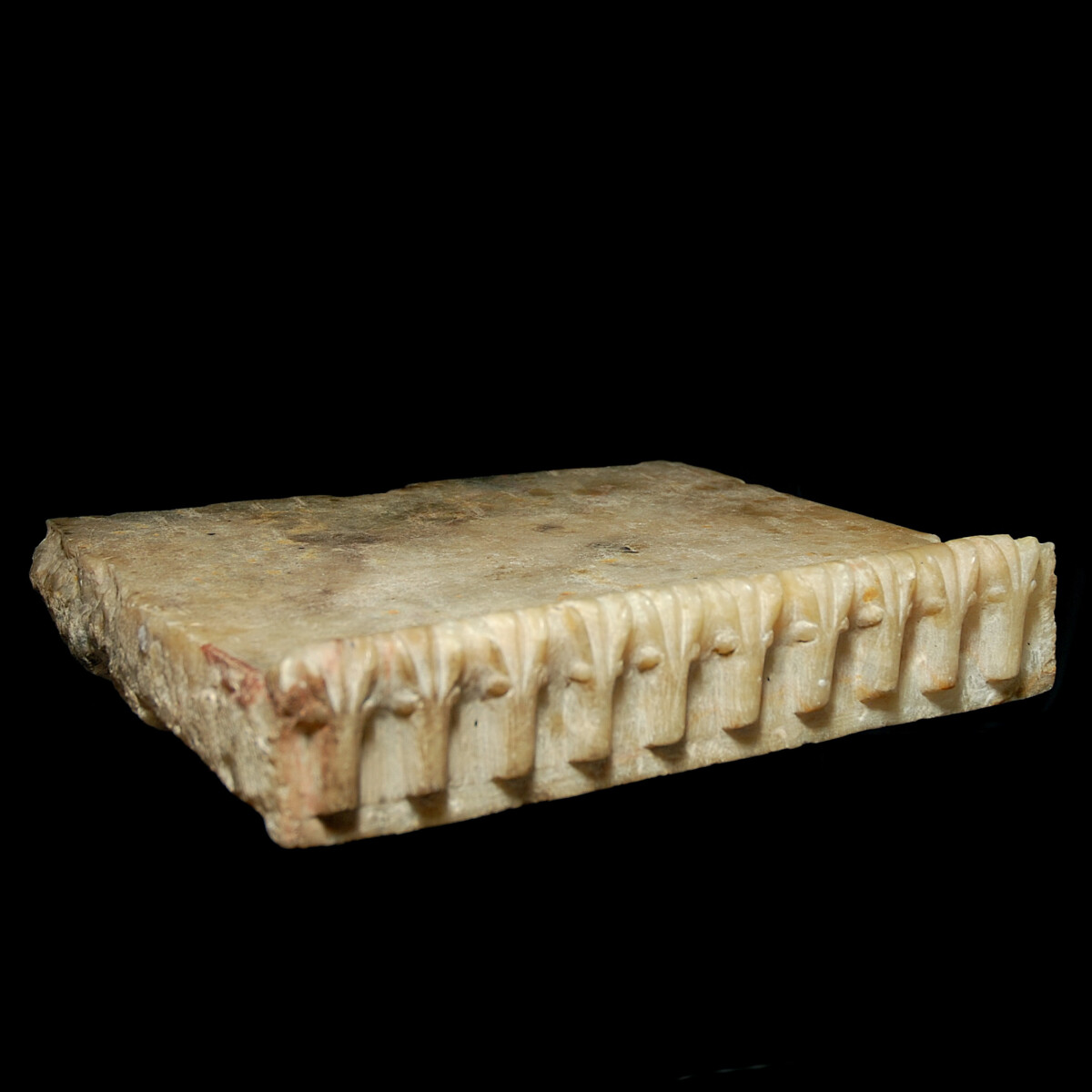
|
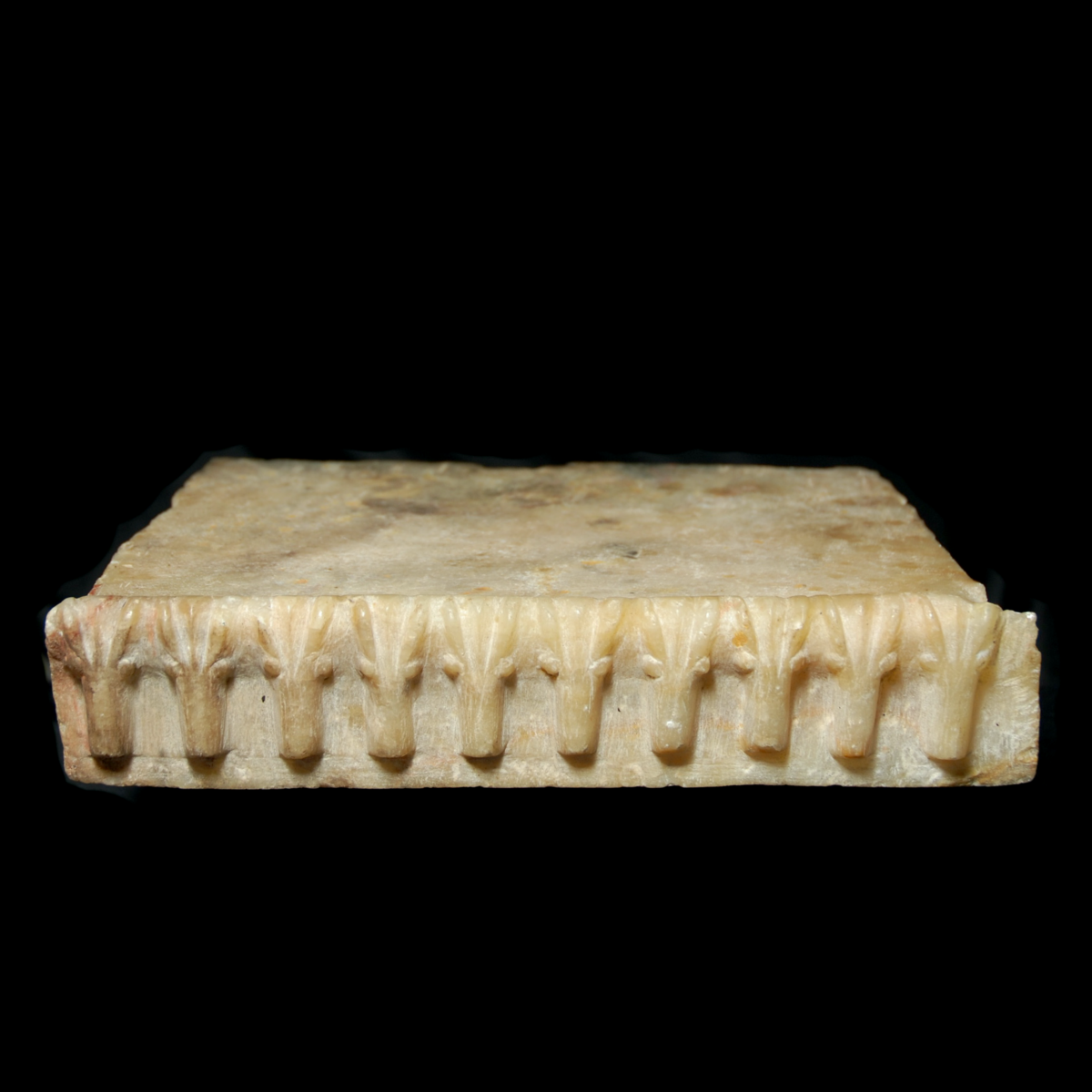
|
|
South Arabia – 4th-3rd century B.C.
|
Large alabaster frieze with ten stylized ibexes which forms the end of an altar plate. The ibexes are en face arranged next to each other. The sculptural heads with long, rectangular snouts and large button-like eyes. The heads tapering towards the top, whereby on the sides the rounded horns are protruding. Behind the frieze a large almost square and on top flattened altar plate. Ibex friezes also appear in the architectural structure of sacral buildings – for example on the Bar’an Temple from Ma’rib. In addition to its importance as a symbolic animal of various southern Arabian deities, the ibex also stands for fertility. See for the type “Jemen – Kunst und Archäologie im Land der Königin von Saba”, Wilfried Seipel (Hrsg.), No. 230, pages 319-320, as well as No. 234, pages 321-322.
|
Provenance: From the private estate of the renowned Parisian art dealer François Antonovich (born 1934), acquired in the 1970s.
Dimensions: 6.2 cm x 27.8 cm x 22.5 cm
Price: 6 000 Euro
|
|
|
Südarabien – 4.-3. Jahrhundert v. Chr.
|
Großer Alabaster-Fries mit zehn stilisierten Steinböcken, der den Abschluss einer Altarplatte bildete. Die Steinböcke sind in Frontalansicht nebeneinander angeordnet. Die plastischen Köpfe mit langer, rechteckiger Schnauze und großen knopfförmigen Augen. Die Köpfe laufen nach oben spitz zulaufend aus, wobei sich seitlich die abgerundeten Hörner absetzen. Hinter dem Fries eine große anhähernd quadratische und oben abgeflachte Altarplatte. Steinbockfriese tauchen als dekoratives Element auch in der architektonischen Gliederung von Sakralbauten – etwa am Bar’an-Tempel von Ma’rib – auf. Neben der Bedeutung als Symboltier verschiedener südarabischer Gottheiten steht der Steinbock auch für Fruchtbarkeit. Vergleiche zum Typus „Jemen – Kunst und Archäologie im Land der Königin von Saba“, Wilfried Seipel (Hrsg.), Nr. 230, Seite 319-320 sowie Nr. 234, Seite 321-322.
|
Provenienz: Aus dem Privatbestand des bekannten Pariser Kunsthändler François Antonovich (geboren 1934), erworben in den 1970er Jahren.
Dimensionen: 6,2 cm x 27,8 cm x 22,5 cm
Preis: 6.000 Euro
|
|
|
|
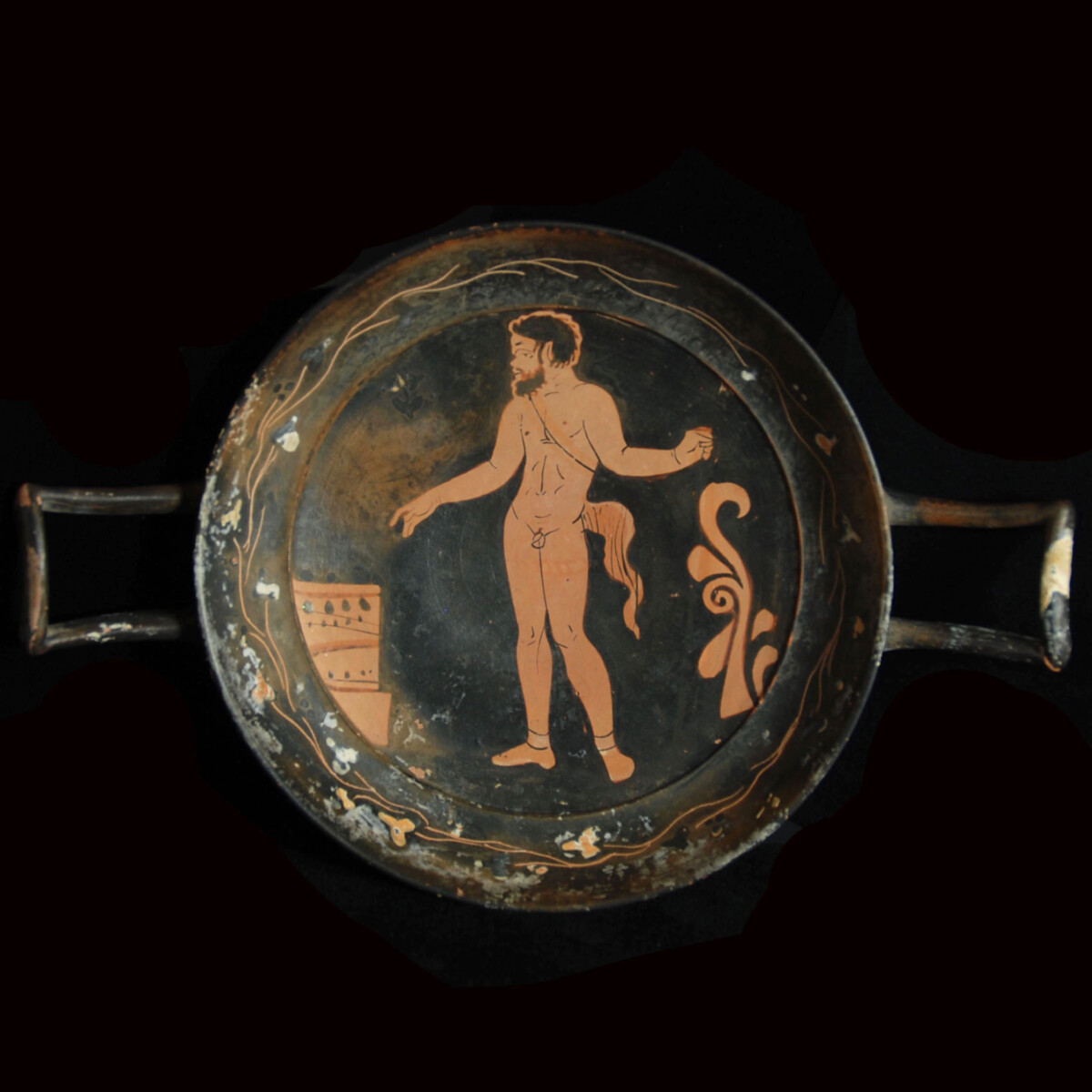
|
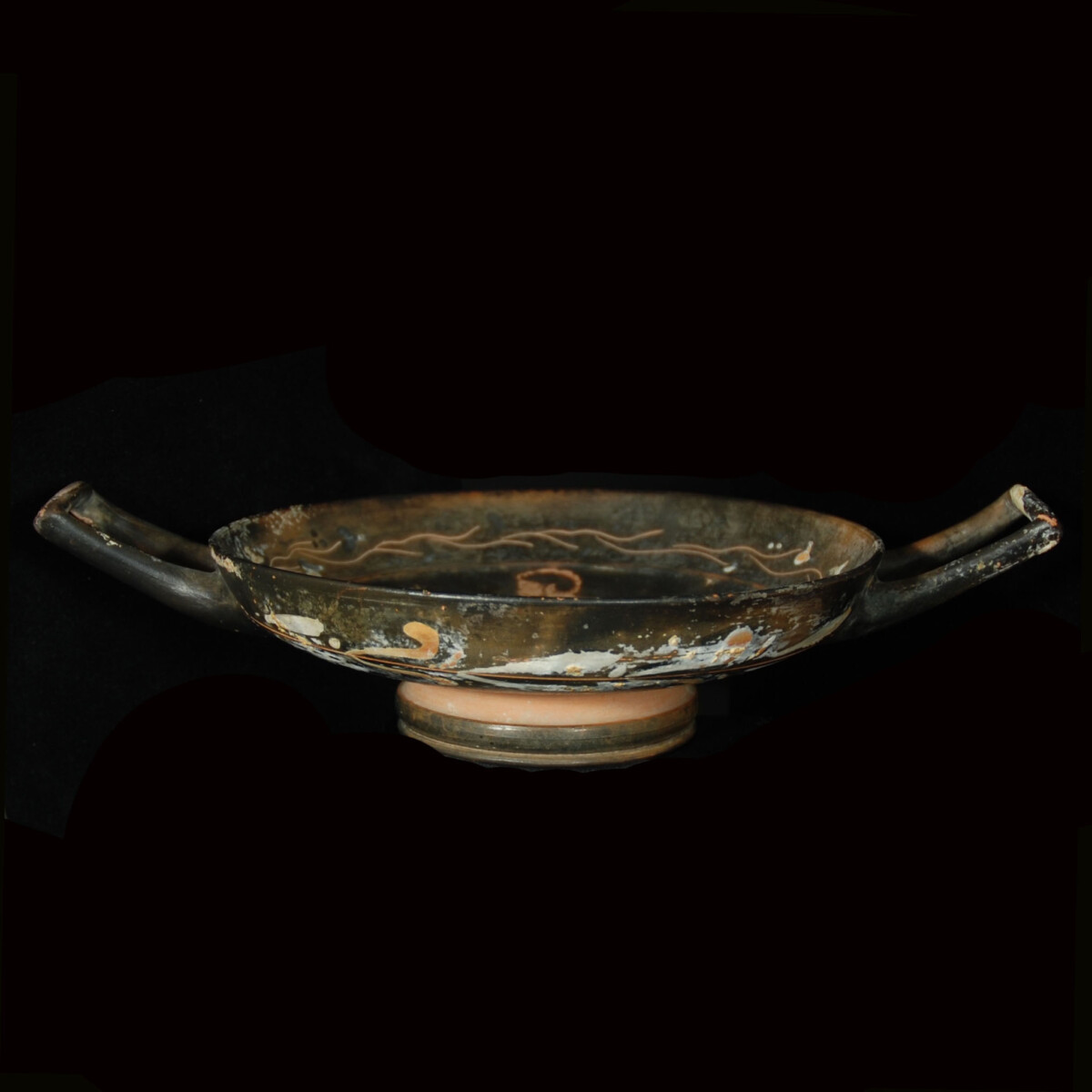
|
|
Greece/Apulia – 4th century B.C.
|
Red-figured kylix from Gnathia with a wonderful depiction of an unclothed Satyr on the inside. The bearded servant of Dionysus facing to the left, he has a long tail and holds in his left hand a staff, possibly the thyrsus. With his right hand he sets fire on a rostrum. The depiction on the inside framed by a rib. Thence vine tendrils incised in the clay with leaves in opaque white. The bottom with laurel leaves, alternately in opaque white and red-figure technique. The handles are far protruding and slightly bent upwards. The drinking cup stands on an offset, profiled foot ring. At the bottom of the foot ring concentric circles.
|
Provenance: Belgian private collection M. & F. Farber, acquired on 22 December 1981 from André de Munter in Brussels, Belgium. With the original invoice of 1981.
Dimensions: 27.5 cm (diameter including handle)
Price: 8 000 Euro
|
|
|
Griechenland/Apulien – 4. Jahrhundert v. Chr.
|
Rotfigurige Kylix aus Gnathia mit einer wunderbaren Darstellung eines unbekleideten Satyrs auf der Innenseite. Der bärtige Diener des Dionysos blickt nach links, er hat einen langen Schwanz und hält in seiner linken Hand einen Stab, wohl den Thyrsos. Mit seiner rechten Hand legt er Feuer auf einem Podest. Die Innendarstellung von einer plastischen Rippe umrahmt. Danach in den Ton geritzte Weinranken mit Blättern in Deckweiß. Die Unterseite mit Lorbeerblättern abwechselnd aus Deckweiß und in rotfiguriger Technik. Die Henkel stehen weit ab und sind leicht nach oben gebogen. Die Trinkschale steht auf einem abgesetzten, profilierten Standring. Auf der Unterseite des Standrings konzentrische Kreise.
|
Provenienz: Belgische Privatsammlung M. & F. Farber, erworben am 22. Dezember 1981 von André de Munter in Brüssel. Mit Original-Rechnung von 1981.
Durchmesser inkl. Henkel: 27,5 cm
Preis: 8.000 Euro
|
|
|
|

|
|
|
|
Central Europe – 9th-8th century B.C.
|
Fibula of a square wire with two opposing coiled spiral discs. Between the spirals sits a double loop. From one of the spiral centres the wire continues as the pin. The catch-plate at the other spiral is formed by a hook-shaped bent wire-end. Brooches like the present one were widespread during the Late Bronze Period to the Early Iron Age in Southeast Germany, Austria, Czech Republic, Slovakia, Poland, Italy up to Greece.
|
Provenance: From a New York private collection, 1990s.
Dimensions: 15.5 cm long
Price: 1 200 Euro
|
|
|
Mitteleuropa – 9.-8. Jahrhundert v. Chr.
|
Fibel aus vierkantigem Draht mit zwei gegenständig aufgerollten Spiralscheiben. Zwischen den Spiralen sitzt eine Achterschleife. Aus dem einen Spiralauge setzt sich der Draht als Nadel fort. Ein hakenförmig gebogenes Drahtende am anderen Spiralauge bildet den Nadelhalter. Fibeln wie diese waren in der jüngeren Bronzezeit bis zur älteren Eisenzeit in Südostdeutschland, Österreich, Tschechien, der Slowakei, Polen, Italien bis hin nach Griechenland verbreitet.
|
Provenienz: Aus New Yorker Privatsammlung, 1990er Jahre.
Länge: 15,5 cm
Preis: 1.200 Euro
|
|
|
|

|
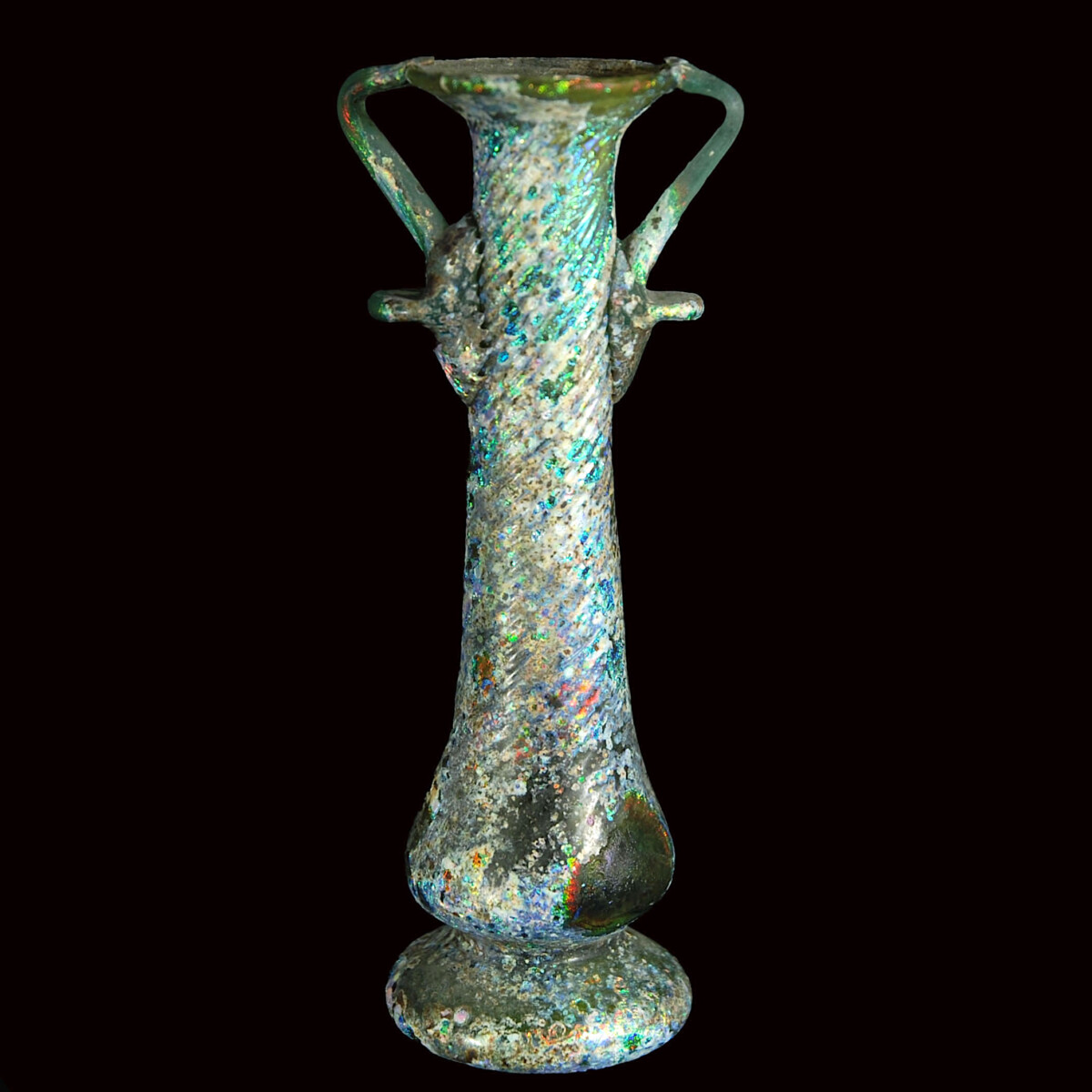
|
|
|
|
Roman Empire – Late 4th to early 5th century A.D.
|
Exceptionally beautifully iridescent perfume glass flask with two handles. The flask with a tubular, inclinedly ribbed body, slightly broadening towards the bottom. The estuary far protruding and thickened. Two curved handles start at the rim, which end in a finger support on the corpus. The flask stands on a set off foot ring with a concave base. From Palestine. See for the form “Römisches, byzantinisches und frühmittelalterliches Glas – Sammlung Ernesto Wolf”, Hatje Cantz 2001, number 143.
|
Provenance: Private collection Shlomo Moussaieff (1925-2015). Acquired between 1948 and 2000.
Dimensions: 12.2 cm high
Price: 1 600 Euro
|
|
|
Römisches Reich – Ende 4. bis Anfang 5. Jahrhundert n. Chr.
|
Außergewöhnlich schön irisierende Parfumflasche aus Glas mit zwei Henkeln. Die Flasche mit röhrenförmigem, schräg geripptem Körper, der nach unten leicht ausschwingt. Die Mündung weit nach außengezogen und heiß verdickt. Am Rand setzen zwei geschwungene Henkel an, die jeweils in einer Fingerstütze am Korpus enden. Das Gefäß steht auf einem abgesetzten Standring mit konkavem Boden. Aus Palästina. Vergleiche zur Form „Römisches, byzantinisches und frühmittelalterliches Glas – Sammlung Ernesto Wolf“, Hatje Cantz 2001, Nummer 143.
|
Provenienz: Privatsammlung Shlomo Moussaieff (1925-2015), Israel. Erworben zwischen 1948 und 2000.
Höhe: 12,2 cm
Preis: 1.600 Euro
|
|
|
|

|
|
|
Bulbous amphora from the Holy Land, which once served as a storage container. The bulbous corpus stands on a flat base. The neck is indented, followed by a funnel-shaped opening. Two small round handles start at the neck and reach to the shoulder. With intensive root traces, which radiates a special appeal to the vessel.
|
Provenance: Viennese private collection Ernst Degasperi (1927-2011), acquired in the 1960s to 1970s. Thence in a family estate.
Dimensions: 18.2 cm high
Price: 900 Euro
|
|
|
Levante – 2300-2000 v. Chr.
|
Kugelige Amphora aus dem Heiligen Land, die einst als Vorratsgefäß diente. Der kugelige Korpus steht auf einer flachen Basis. Der Hals eingezogen, daran anschließend die trichterförmige Öffnung. Zwei kleine runde Henkel setzen am Hals an und reichen bis zur Schulter. Mit intensiven Wurzelspuren, die dem Gefäß eine besondere Ausstrahlung verleihen.
|
Provenienz: Wiener Privatsammlung Ernst Degasperi (1927-2011), erworben in den 1960er bis 1970er Jahren. Seitdem in Familienbesitz.
Höhe: 18,2 cm
Preis: 900 Euro
|
|
|
|

|
|
Roman Empire – 2nd century A.D.
|
Cast, massive bronze applique in form of a stylized phallus. The upper side trapezoid, at the bottom two semi-circular indentations of the scrotum. At the front the tapering penis. The end is formed by a bronze granule. In the upper corners two perforations for suspension, in one is an ancient rivet. Phallus depictions were popular in the Roman Empire. They were worn as charms and should protect against the evil eye. Even children wore them as amulets. But they were also fixed on furniture and other objects to have an apotropaic function.
|
Provenance: Since the early 1980s in a German private collection.
Dimensions: 2.5 cm x 2.8 cm
Price: 480 Euro
|
|
|
Römisches Reich – 2. Jahrhundert n. Chr.
|
Gegossene, massive Bronze-Applike in Form eines stilisierten Phallus. Die Oberseite trapezförmig, unten zwei halbrunde Ausbuchtungen des Skrotums. Vorne steht das spitz zulaufende Glied ab. Den Abschluss bildet ein Bronze-Granulat. In den oberen Ecken zwei Lochungen zur Aufhängung, in einer steckt noch eine antike Niete. Phallus-Darstellungen waren im römischen Reich weit verbreitet. Sie wurden als Glücksbringer getragen und sollten vor dem bösen Blick schützen. Schon Kinder trugen sie als Amulette. Sie wurden aber auch an Möbeln und anderen Gegenständen angebracht, um apotropäisch zu wirken.
|
Provenienz: Seit den frühen 1980er Jahren in deutschem Privatbesitz.
Dimensionen: 2,5 cm x 2,8 cm
Preis: 480 Euro
|
|
|
|
|
|
|
|
|
CHRISTOPH BACHER ARCHÄOLOGIE ANCIENT ART GmbH
|
Galerie: Stubenring 20, A-1010 Wien
Showroom: Untere Viaduktgasse 55, A-1030 Wien
|
|
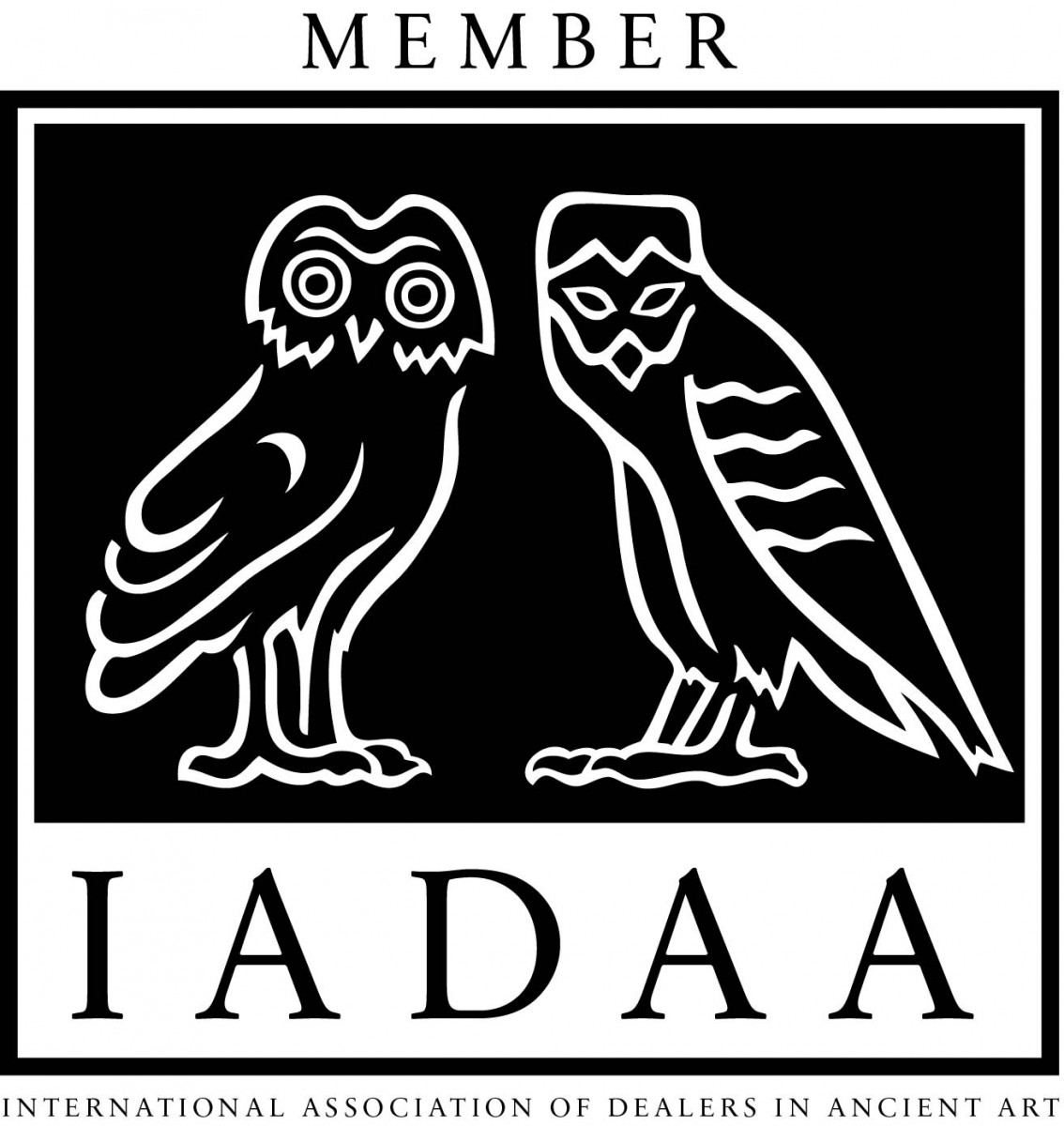
|
|
|
|